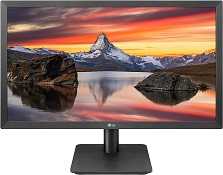What is an LCD monitor?
An LCD monitor, or Liquid Crystal Display monitor, is a type of display technology commonly used in computer monitors, televisions, and other electronic devices. It utilizes a liquid crystal layer sandwiched between two transparent electrodes to create images and display content.
LCD monitors consist of several key components:
- Liquid Crystal Layer: This layer is made up of tiny liquid crystal molecules that can be manipulated to control the passage of light.
- Backlighting: LCD monitors require a backlight source to illuminate the liquid crystal layer. Early LCD monitors used cold cathode fluorescent lamps (CCFLs) as backlighting, but modern LCDs often use light-emitting diodes (LEDs) for backlighting, resulting in better energy efficiency and thinner displays.
- Color Filters: LCD monitors employ color filters to produce colors. These filters, typically red, green, and blue, are placed in front of each pixel to create the desired color spectrum.
- Thin-Film Transistor (TFT) Array: A TFT array is a grid of tiny transistors that control the voltage applied to each pixel, determining the amount of light that passes through and creating the displayed image.
When an electrical current is applied to the liquid crystal molecules, they twist and reorient to control the passage of light through the color filters. By manipulating the liquid crystals at each pixel using the TFT array, the monitor can display different colors and shades.
Pros and cons
Pros of LCD Monitors
- Image Quality: LCD monitors can provide high-quality images with sharp details and vibrant colors. They generally have high resolutions and offer better clarity compared to older display technologies.
- Space Efficiency: LCD monitors are thinner and lighter than their CRT (Cathode Ray Tube) counterparts, making them space-efficient. They take up less desk space and are easier to mount on walls or monitor arms.
- Energy Efficiency: LCD displays are more energy-efficient than CRT monitors since they use less power. Reduced environmental effect and decreased electricity costs may arise from this.
- Reduced Eyestrain: These monitors have a flicker-free display, which helps reduce eyestrain and fatigue, especially during extended periods of computer use
- Wide Viewing Angles: LCD technology offers wider viewing angles, meaning the image remains consistent and colors don’t distort when viewed from different angles. This is beneficial for group viewing or when you need to view the screen from different positions.
Cons of LCD Monitors
- Limited Refresh Rates: LCD monitors typically have lower refresh rates compared to gaming-oriented technologies like CRT or newer technologies like OLED. This can result in motion blur or ghosting in fast-paced scenes, making them less ideal for gaming or high-motion applications.
- Limited Color Accuracy: While LCD monitors have improved over the years, achieving perfect color accuracy can still be challenging. Some models may struggle with color calibration, leading to variations in color representation.
- Limited Contrast Ratios: LCD monitors can have limitations in achieving deep blacks and high contrast ratios compared to technologies like OLED or high-end LED displays. This can result in less dynamic and immersive visual experiences.
- Response Time: LCD monitors may have slower response times, particularly in older or budget models. This can cause motion blur or smearing in fast-moving content, affecting the overall visual experience, especially for gaming or video playback.
- Backlighting Issues: Certain LCD monitors may exhibit backlight bleeding or uneven backlight distribution, causing areas of the screen to appear brighter or darker than intended. This can be noticeable, particularly when viewing dark or black content.
It’s important to note that LCD technology has evolved significantly, and many of these drawbacks have been mitigated or improved in newer models. Additionally, specific models and brands may have different performance characteristics, so it’s advisable to consider individual product specifications and reviews when choosing an LCD monitor.
Final words
LCD monitors have revolutionized the display industry with their slim design, high image quality, and energy efficiency. With advancements in technology, LCD monitors offer users sharp and vibrant visuals, making them well-suited for various applications, including professional work, entertainment, and everyday computer use. While there are limitations such as slower response times and color accuracy challenges, these issues have significantly improved in newer models.
As a result, LCD monitors continue to dominate the market, providing users with an optimal balance of performance, space efficiency, and visual appeal. With ongoing advancements, it is exciting to anticipate the future developments that will further enhance the LCD monitor experience for users worldwide.

